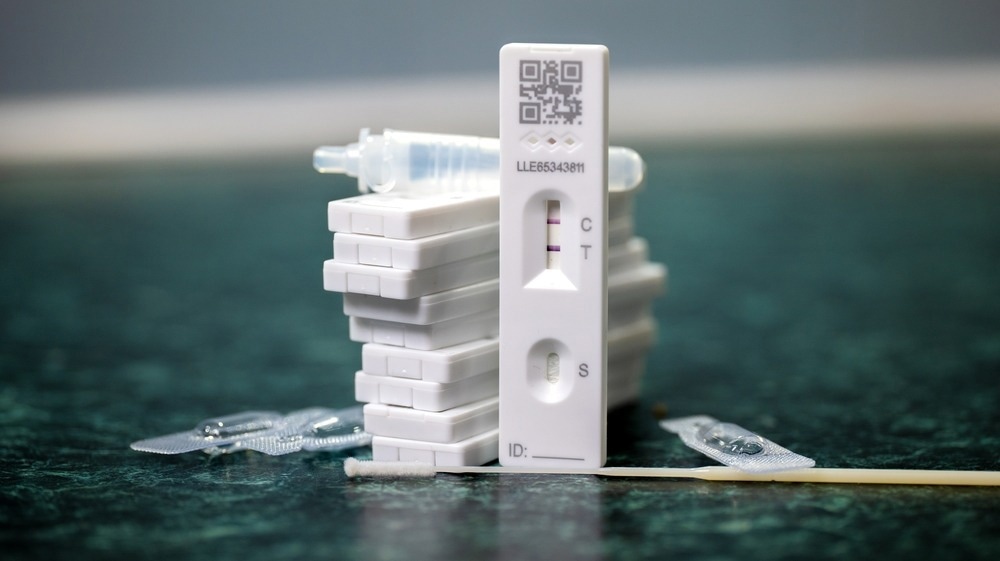 By Neha MathurReviewed by Danielle Ellis, B.Sc.Sep 19 2022
By Neha MathurReviewed by Danielle Ellis, B.Sc.Sep 19 2022In a recent study posted to the medRxiv* server, a team of researchers investigated how antigen concentration and viral load in different specimen types affected the performance of severe acute respiratory syndrome coronavirus 2 (SARS-CoV-2) rapid diagnostic tests (RDTs).
 Study: Antigen concentration, viral load, and test performance for SARS-CoV-2 in multiple specimen types. Image Credit: ilze kalve/Shutterstock
Study: Antigen concentration, viral load, and test performance for SARS-CoV-2 in multiple specimen types. Image Credit: ilze kalve/Shutterstock

 *Important notice: medRxiv publishes preliminary scientific reports that are not peer-reviewed and, therefore, should not be regarded as conclusive, guide clinical practice/health-related behavior, or treated as established information.
*Important notice: medRxiv publishes preliminary scientific reports that are not peer-reviewed and, therefore, should not be regarded as conclusive, guide clinical practice/health-related behavior, or treated as established information.
Background
Understanding the antigen concentration and viral load dynamics in different specimen types can inform how RDTs perform across infection stages and use-case scenarios of coronavirus disease 2019 (COVID-19). Both these variables, nucleocapsid (N)-antigen concentration and viral loads vary across different specimen types and between individuals. Additionally, relative viral loads vary with the SARS-CoV-2 variant and vaccination status.
The reverse transcriptase-polymerase chain reaction (RT-PCR) remains the gold standard for SARS-CoV-2 detection in nasopharyngeal swab (NPS) specimens, regardless of the specimen source for the index test. The antigen concentration in the sampled oral or nasal cavity and viral copies in the NPS specimens restricted the comparison of RDT performance relative to RT-PCR. Yet, the RDTs performance was compared with RT-PCR during the early phases of the COVID-19 pandemic for regulatory purposes.
About the study
In the present study, researchers presented the results of reference antigen concentration measurements on specimens collected for a study conducted in Porto Velho, Brazil, in 2021 to determine the correlations between antigen concentration and viral load on RDT performance.
The study included 214 contacts aged 12 years and older and with different vaccination statuses, with recent exposures to confirmed COVID-19 cases. They measured antigen concentration in NPS, anterior nares swabs (ANS), and saliva specimens. Subsequently, they performed RT-PCR on the NPS and saliva specimens. Likewise, they did two RDTs on ANS specimens and one using saliva specimens.
Study findings
The NPS antigen concentration corresponded to NPS viral load, and the saliva antigen concentration measured in saliva samples correlated with cycle threshold (CT) values from the SalivaDirect assay. However, the antigen concentrations in ANS and saliva specimens did not correlate with the viral load measured in the same study participants’ NPS specimens. The results confirmed higher antigen concentrations in symptomatic cases compared to asymptomatic and oligosymptomatic cases across all three specimen types. The overall lower antigen levels observed in saliva in this study suggested that currently used RATs are not sensitive enough to leverage this opportunity for early SARS-CoV-2 infection detection.
The study population covered symptomatic, asymptomatic, and oligosymptomatic cases. Likewise, the study samples had low viral load and low antigen concentrations. Larger data sets of paired viral load and antigen concentration measurements across different sample types, variants, and different study populations may improve the ability to predict the performance of antigen detection tests in different scenarios and use cases.
This study showed that discordant results are possible if the specimen source for the RDT is different from the specimen used to measure viral load using RT-PCR. Within a specimen type - antigen concentration and antigen-based detection test performance could relate to viral load. Discordant results between the RT-PCR on NPS specimens and the RDTs conducted on ANS could, thus, be attributable to the antigen concentration values. These results also elucidate differences in performance observed for SARS-CoV-2 tests across different sample types.
Conclusions
The current study showed the value of understanding the underlying antigen concentration dynamics and its relationship to viral load across different sample types to inform and predict RDT performance across settings, SARS-CoV-2 variants, and use cases.
Saliva samples have lower antigen concentrations, so tests using saliva specimens require more analytical sensitivity to attain clinical sensitivity comparable to nasal samples. The antigen dynamics across different sample types observed in SARS-CoV-2 disease progression support the use of RDTs in nasal samples. To summarize, the analytical limit-of-detection of RDTs could help predict the performance of the RDTs in populations for which the antigen concentration is known.

 *Important notice: medRxiv publishes preliminary scientific reports that are not peer-reviewed and, therefore, should not be regarded as conclusive, guide clinical practice/health-related behavior, or treated as established information.
*Important notice: medRxiv publishes preliminary scientific reports that are not peer-reviewed and, therefore, should not be regarded as conclusive, guide clinical practice/health-related behavior, or treated as established information.